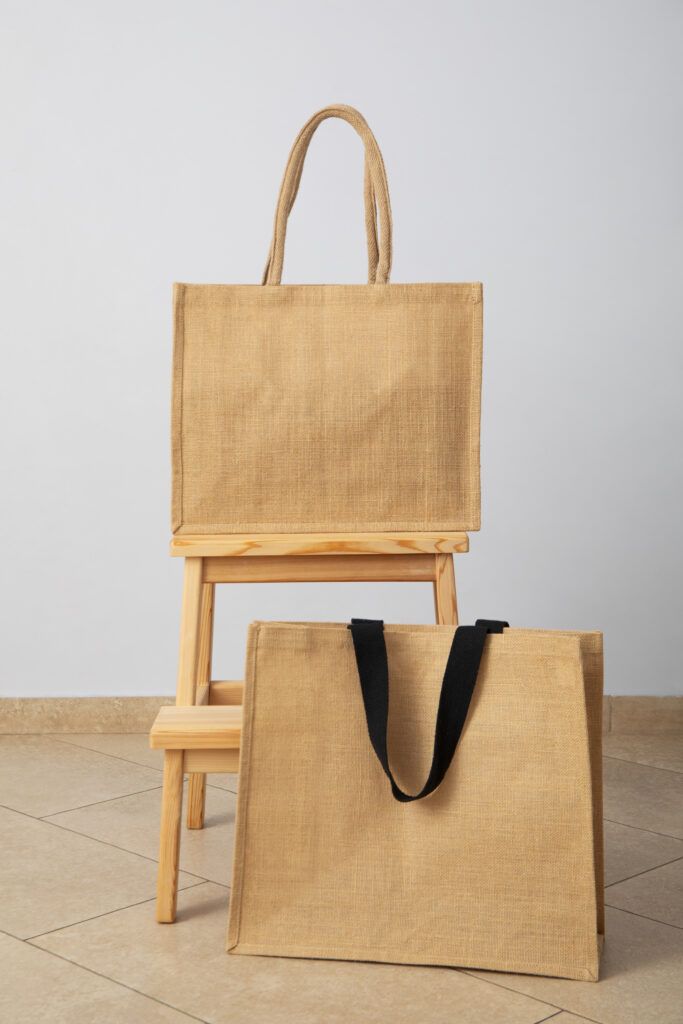The practice of using the nifty vegetable fibre obtained from the jute plant in crafting utilitarian products dates long back. Previously, jute was mostly used to make sturdy storage aids like gunny bags and ropes as well. A utility carrier crafted from jute is called a jute bag. However, the answer may seem lucid but the process includes a thorough step-by-step approach.
Now to answer the first question logically, we shall have to walk you through a short glimpse of the field to the factory. The process of turning jute plants into fabric involves quite a few rigorous steps. After harvesting the plant, it is soaked into water and allowed to decay. When the plants start to decay, the fibre either naturally detaches from the plant or is pulled out manually by a process called stripping. Up next comes a step called carding in which the chemically treated fibres and converted into fabrics to weave out shapes as needed. The fabric which is prepared is dyed or screen printed to create amazing patterns and textures. After achieving all these steps, a skilled craftsman weaves out a beautiful jute bag from the fabric. Although the process might sound mammoth and hectic, yet it is not difficult to obtain many practical accessories manufactured with jute fibre after a single harvest. After a series of jute bags are made, they are sent to various retail stores to make the customers happy. We at Kandhi.in have achieved a sterling rank in crafting and vending exquisite premium jute bags and other articles of daily need. We have become a well-recognized name among our customers for our high-quality washed jute accessories.
Jute Bags are avidly useful and have a plethora of benefits. Here is some of its usefulness listed:
- Eco-friendly: As jute bags are made from plant fibres, the accessories are completely eco-friendly. The items made from jute are bio-degradable and do not add up to the carbon load of the planet. Also, jute is organic; hence no animals are harmed or killed to weave a product out of the fibre. It degenerates naturally and mixes with the soil if thrown out, unlike plastic that no way mixes with the soil multiplying the number of waste materials.
- Sustainable: The primal motto of jute being used to make a set of accessories was to meet the needs of the hour and create a range of sustainable products. It is of utmost importance to get rid of plastic contraptions slowly and steadily to raise awareness of wearing the green collar. To make the process of bidding adieu to the hazardous and non-biodegradable plastic products faster, jute bags are quintessential additions.
- Economical: Jute can be harvested quite a few times all over the year making it a very budget-friendly material to use in any type of production. The labours are also indigenous and most of them are masters of their trades. They can weave out many jute accessories within a very short period with their sheer finesse. Hence most jute bags and other products come maintaining a steady economical margin.
- Endearing: Jute products are sturdy and tackle heavy wear and tear easily. Previously, jute was used to make sacks and ropes for its heavy-duty performance and hardiness. Humongous loads were carried in them and they remained intact even with multiple usages. This old track record of the amazing jute fibre certifies the endearing quality of the jute bags undoubtedly.
Now, if we come to the last and final part of the series of questions given, it is better to say that the comparison between cotton products and jute commodities can initiate ripples of debate. The texture, nature and quality of both the fibres are distinctive; hence it is difficult to rank one above another. Cotton products have enjoyed the spotlight for a long due to their widespread usages. However, in the following points, we have tried to accentuate the little differences making jute a superior fibre and we hope that time is not long when jute will be used to meet the daily requirements of people.
- Jute Bags are cheaper than cotton: Jute grows ideally in the humid weather of the Gangetic plains and it can be harvested quite a few times all over the year. As it involves lesser effort to create fabric out of fibre in the case of jute, Jute bags are cheaper than cotton.
- Jute Bags can sustain greater loads: Jute is strong enough to withstand heavier loads and can sustain the process of erosion more effectively. Cotton products are lighter than jute and can corrode easily if you expose them regularly to a rough usage pattern.
We hope that our answers will clear your doubts about Jute accessories. If you are looking forward to adding stylish, long-lasting, 100% Made in India and premium jute products to your ensemble, explore https://kandhi.in/








